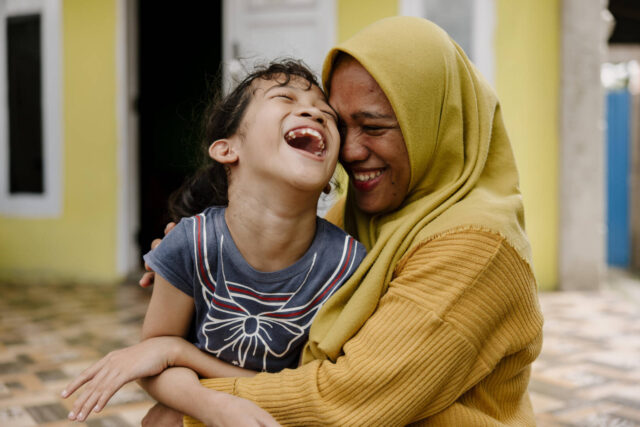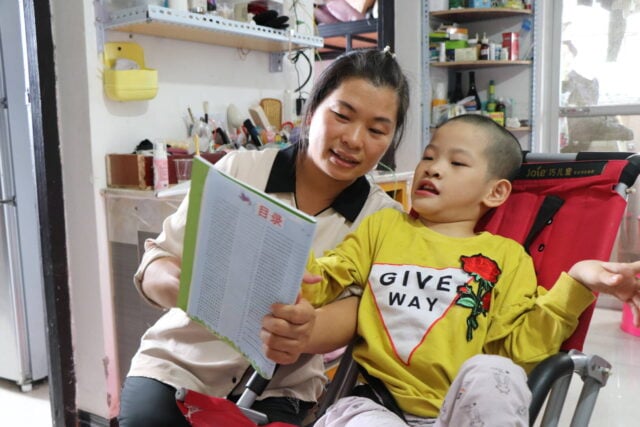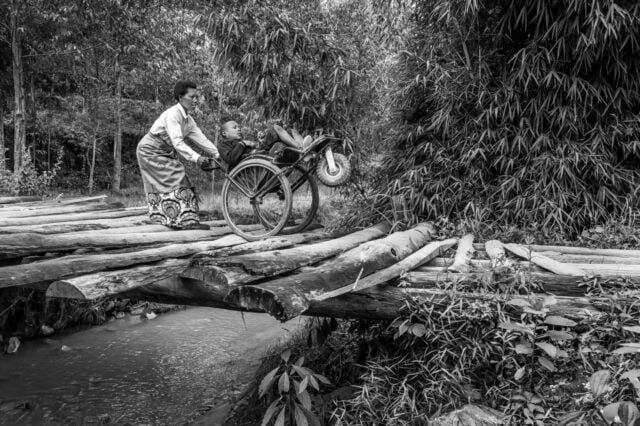
Disability Inclusion
Around the world, one in six people live with a significant disability, with higher levels of disability among women, the elderly, and people living in poverty.
We support the global rallying cry of the community of people with disabilities, “Nothing without us” — including people with disabilities in all we do, so all people can be part of the solutions to poverty.
1.
- Access to services and assets – by making sure persons with disabilities can access health, education, livelihoods, WASH and other services and the specialized rehabilitation and assistive technology services they need.
2.
- Enhanced well-being – by ensuring that protection and GBV prevention systems mitigate the increased risk of violence towards children and adults with disabilities.
3.
- Participation within social, economic and political processes in their community and nationally – by supporting and encouraging persons with disabilities to participate in these processes and process managers to make processes more accessible and inclusive
4.
- Decision-making at household, community and societal level – by raising up persons with disabilities and facilitating their ability to engage in decisions
5.
- Equal systems – by addressing stigma towards persons with disabilities in their communities and supporting community and national level advocacy by disabled person organizations and individuals to align laws and processes with national legislation linked to commitments to the UN Convention on the Rights of Persons with disabilities.
Disability FAQs
What is disability inclusion and why focus on it?
Disability inclusion is one aspect of social inclusion, the process of transforming social relations and structures so that people and groups who are traditionally marginalized have increased opportunities, power, rights, access to resources, and agency. This enables them to shape cultural, economic, and political systems and participate in all aspects of social life. People can be marginalized due to many aspects of their identity, and women with disabilities often experience dual discrimination based on their gender and disability.
People with disabilities experience exclusion not only because of physical, cognitive, or sensory impairments, but also from societal barriers that limit their meaningful participation. Though people with disabilities often need services such as rehabilitation or assistive technology, these services alone won’t address the root causes of exclusion. Only breaking down barriers in a community can do that.
What barriers do people with disabilities face and what is your approach in breaking them down?
People with disabilities face many forms of barriers in society, such as inaccessible environments (lack of wheelchair ramps or accessible latrines), harmful stereotypes or stigma around disability, and institutional structures not being accessible, such as laws and policies that do not consider the unique needs and contributions of people with disabilities. Women and girls with disabilities are further marginalized by barriers such as rigid gender roles and lack of decision making power in households and communities.
We conduct thorough analyses of gender equality and social inclusion in communities so we understand the barriers in specific contexts that marginalized people, including people with disabilities, face. We apply a twin-track approach to meeting the needs of people with disabilities by partnering with technical experts to offer rehabilitation services and then helping to break down societal barriers through our strong community and government relationships. By embedding rehabilitation services within community development activities, we come alongside qualified service providers and build an enabling environment for disability inclusion.
How do you inspire change in the communities where you work?
We promote attitudinal and behavioral change through training, advocacy, and stakeholder engagement, and ensure that universal access is a part of all reconstruction and infrastructure work. Engaging those with disabilities throughout program design, implementation, and evaluation is key to the success of disability inclusion.
Project integration examples
To implement programs effectively, World Vision trains staff to understand disability issues and address any stigma they may have toward persons with disabilities.. World Vision also trains staff on how they can support inclusion of disability issues throughout the project cycle. World Vision uses our social accountability tool, Citizen Voice and Action, to support the inclusion of persons with disabilities in social, political and decision-making processes.
Advocacy
The USAID-funded Training, Economic Empowerment, Assistive Technology and Medical/Physical Rehabilitation Services (TEAM) project engaged 2,749 persons with disability in CVA processes in Colombia within 18 groups. Each group produced an action framework. They prioritized the most frequently violated rights for people with disabilities including delays in receiving care, the shortage of available appointments with health specialists, limited accessibility in parks and other community settings, and the limited opportunities for employment and income generation. Local authorities listened to CVA groups and expressed verbal commitment to addressing the issues raised. A total of 175 actions were directly attributed as responses to CVA processes. Groups then monitored progress towards these commitments. Perhaps the greatest impact of the CVA groups, was the strengthening of relationships around disability, resulting in greater solidarity, understanding and support.
“The TEAM project and CVA helped a lot of people to understand, and to energize and gather people through the Local Action Boards. I think it was a success.”
–Jorge, project participant, Barranquilla
Education
Primary and pre-primary
World Vision has integrated inclusive education as part of our two main program models, Learning Roots focusing on children 3-5 years old and Unlock Literacy focusing on grades 1-3. Program delivery is universal in design, allowing children to receive information in different ways and to express their learning in different ways. Community-based reading camps supplement learning for children who need additional assistance to enhance their literacy. We also focus on increasing acceptance and the environment for the inclusion of children with disabilities in school.
In Malawi, our inclusive education program nearly doubled the numbers of children with disabilities attending school within a three-year period. We worked with 80 community leaders, including five chiefs to shift negative norms around disability. As a result, 21% of adults interviewed said they had a child with disability in their family, whereas previously these children were hidden.
Development of inclusive, accessible learning materials
All Children Reading: A Grand Challenge for Development (ACR GCD)—a partnership of USAID, World Vision, and the Australian Government—advances EdTech innovation and research to improve reading outcomes for marginalized children in low-resource contexts. Through global grant and prize competitions, ACR GCD identifies and brings to scale the most promising EdTech solutions for addressing barriers that prevent children with disabilities from learning to read. ACR GCD has also funded extensive research, including adaptation of the Early Grade Reading Assessment, to ensure children with disabilities are included in measurements of literacy acquisition and skills. Read more about All Children Reading’s innovations for children with disabilities.
Youth
In Guatemala, World Vision implements the USAID-funded Puentes Project to improve the quality of life for youth ages 15-24 in the Western Highlands of Guatemala. This project focuses on particularly marginalized youth, including youth with disabilities. Vulnerable youth receive the information, knowledge, and skills to gain employment and economic opportunities as well as education, health, and social services. They also learn to engage local government, the private sector, and service providers to improve access to quality services and generate new employment and economic opportunities. Project Puentes partners with a local federation of disabled people’s organizations to identify and recruit participants with disabilities and to ensure positive representation of youth with disabilities in the training materials and radio broadcasts. By partnering with a DPO, making activities and content accessible and communications inclusive, Project Puentes seeks to be transformational in increasing access to services, decision-making, equitable systems, and meaningful participation of people with disabilities.
In Ethiopia, the Engaged, Educated, Empowered Ethiopian Youth (E4Y) project, funded by USDOL, addressed exploitative child labor in Ethiopia by promoting education and vocational training opportunities and enhancing livelihoods opportunities and access to social protection programs for youth and their households. E4Y worked with male and female youth from 7,500 households in Ethiopia, emphasizing inclusion of youth with disabilities while exploring opportunities for disability inclusion in the Ethiopian workplace. The project also focused on education by challenging teacher perceptions of gender norms and disability, aiming to improve teachers’ ability to meet the specific needs of children with disabilities. Youth with disabilities were provided with the necessary adaptive devices to access education and training, such as eyeglasses, crutches and wheelchairs.
WASH
Because World Vision often begins its work in communities with water, sanitation and hygiene (WASH projects) World Vision recognizes that WASH projects must be disability inclusive to:
- achieve the basic human right to water and sanitation
- reach the most vulnerable
- set the tone for inclusion in other community-based projects to increase access
World Vision has worked with disabled person organizations and specialist disability NGOs to develop activities that ensure that WASH programs are inclusive, and that accessible infrastructure and adaptive devices are available. Please see our Clean Water page for more information on our WASH work.
Health
World Vision supports the inclusion of children and adults with disabilities in the provision of health services, including in accessible forms and locations World Vision has implemented programs that provide wheelchairs and other specialized rehabilitation support. World Vision uses its extensive health partnerships in communities to identify persons with disabilities, refers them to specialized disability service providers and then follows up at community level to make sure the services have improved their health and function.
ACCESS and Scaling Up 8+ – With funding from USAID, World Vision led the Accelerating Core Competencies for Effective Wheelchair Service and Support (ACCESS) project in India, Nicaragua, Romania, El Salvador, and Kenya. ACCESS strengthened the wheelchair sector and ensured that people with mobility limitations could access appropriate wheelchairs through qualified service providers and enjoy full participation in their communities. The project succeeded in providing wheelchair service to 7,319 clients and training 911 rehabilitation professionals on World Health Organization courses for wheelchair service. At the end of the project, 93% of wheelchair clients surveyed indicated that they experienced increased community participation and 43 wheelchair service centers showed increased capacity for service.
This link between service provision and community development was the innovation of the ACCESS program, which is now being scaled up across World Vision’s wheelchair programs through our holistic approach Scaling Up 8+, providing wheelchairs and funding to bring sustainable innovation to existing wheelchair programs in Malawi, Kenya, El Salvador, Uganda, India and Tanzania.
The USAID-funded Training, Economic Empowerment, Assistive Technology and Medical/Physical Rehabilitation Services (TEAM) project enabled 3,670 people with disabilities in Colombia to become more independent and integrated into society. The project used mobile clinics coupled with telemedicine to make AT services more accessible to rural populations. WV worked with community-based actors and health systems to identify people for screening and ensure they had the correct documentation to access health insurance. An initial visit by a multi-disciplinary team conducted the screening and assessment. A second visit provided AT devices. Follow-up was then provided through telemedicine that connected community-based primary health service providers with specialists.
Economic Empowerment
Persons with disabilities and their families are up to four times more likely to be living in poverty as a result of lower levels of education, the cost of accessing health and rehabilitation services and productivity lost when care is required for the person with disability. When World Vision identifies a person with disability, we ensure that they can access any financial assistance provided by the government and government and NGO support programs.
The USAID-funded TEAM project worked with persons with disabilities and their families in Colombia to increase their economic well-being. TEAM organized them into productive groups and provided them with the necessary skills and inputs to increase their income by an average of 28%. These groups also provided critical emotional and informational support.
Disability Resources
The evaluation of the USAID-funded ACCESS project found that the project adequately strengthened the wheelchair sector and ensured that all people with mobility limitations, especially women and children, can enjoy full participation in their communities.
A Holistic Approach to Disability Inclusion (PDF)
World Vision applies a twin-track approach to meeting the needs of people with disabilities.
Give to Disability Inclusion
Wheelchair for a child
Give the gift of mobility to a child with a disability.
For children in developing countries who are unable to walk, a custom-fit wheelchair or prosthetic device can make a life-changing difference. For example, in some communities, a child who’s unable to walk may not be able to attend school or participate in community events unless a parent or sibling carries them — until they receive the gift of a wheelchair.
Thanks to our partnership with Free Wheelchair Mission and other organizations—and to donors like you—we’re helping to meet a variety of needs so kids with disabilities can experience fuller lives.
Become a Children with Disabilities Partner
Having a disability shouldn’t mean being excluded from community or care. Over 1 billion people around the world have some form of disability — many of them children. Whether affected from birth or as a result of disease, land mines, or other injuries, children with disabilities in developing countries often find themselves isolated, lonely, and with little hope.
You can help these kids reach for their God-given potential — equipping them to attend school, play with others, participate in their communities and in decisions that affect them, get specialized resources and care, and feel fully supported.
Monthly giving is the most effective way to help children and families who need it most. Plus, it lowers costs, which means more of your gift helps kids!
Wheelchair for a child
Give the gift of mobility to a child with a disability.
For children in developing countries who are unable to walk, a custom-fit wheelchair or prosthetic device can make a life-changing difference. For example, in some communities, a child who’s unable to walk may not be able to attend school or participate in community events unless a parent or sibling carries them — until they receive the gift of a wheelchair.
Thanks to our partnership with Free Wheelchair Mission and other organizations—and to donors like you—we’re helping to meet a variety of needs so kids with disabilities can experience fuller lives.
Become a Children with Disabilities Partner
Having a disability shouldn’t mean being excluded from community or care. Over 1 billion people around the world have some form of disability — many of them children. Whether affected from birth or as a result of disease, land mines, or other injuries, children with disabilities in developing countries often find themselves isolated, lonely, and with little hope.
You can help these kids reach for their God-given potential — equipping them to attend school, play with others, participate in their communities and in decisions that affect them, get specialized resources and care, and feel fully supported.
Monthly giving is the most effective way to help children and families who need it most. Plus, it lowers costs, which means more of your gift helps kids!
Wheelchair for a child
Give the gift of mobility to a child with a disability.
For children in developing countries who are unable to walk, a custom-fit wheelchair or prosthetic device can make a life-changing difference. For example, in some communities, a child who’s unable to walk may not be able to attend school or participate in community events unless a parent or sibling carries them — until they receive the gift of a wheelchair.
Thanks to our partnership with Free Wheelchair Mission and other organizations—and to donors like you—we’re helping to meet a variety of needs so kids with disabilities can experience fuller lives.
Become a Children with Disabilities Partner
Having a disability shouldn’t mean being excluded from community or care. Over 1 billion people around the world have some form of disability — many of them children. Whether affected from birth or as a result of disease, land mines, or other injuries, children with disabilities in developing countries often find themselves isolated, lonely, and with little hope.
You can help these kids reach for their God-given potential — equipping them to attend school, play with others, participate in their communities and in decisions that affect them, get specialized resources and care, and feel fully supported.
Monthly giving is the most effective way to help children and families who need it most. Plus, it lowers costs, which means more of your gift helps kids!





